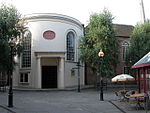Worcester, England

Worcester ( (listen) WUUS-tər) is a cathedral city and the ceremonial county town of Worcestershire, England, 30 miles (48 km) south-west of Birmingham, 101 miles (163 km) north-west of London, 27 miles (43 km) north of Gloucester and 23 miles (37 km) north-east of Hereford. The estimated population in 2019 was 102,791.The River Severn flanks the western side of the city centre. It is overlooked by Worcester Cathedral. Worcester is the home of Royal Worcester Porcelain, composer Edward Elgar, Lea & Perrins, makers of traditional Worcestershire sauce, the University of Worcester, and Berrow's Worcester Journal, claimed as the world's oldest newspaper. The Battle of Worcester in 1651 was the final one in the English Civil War, where Oliver Cromwell's New Model Army defeated King Charles II's Royalists.
Excerpt from the Wikipedia article Worcester, England (License: CC BY-SA 3.0, Authors, Images).Worcester, England
Shambles Entry, Worcester, England Red Hill
Geographical coordinates (GPS) Address Nearby Places Show on map
Geographical coordinates (GPS)
| Latitude | Longitude |
|---|---|
| N 52.192 ° | E -2.22 ° |
Address
Marks & Spencer
Shambles Entry
WR1 2QN Worcester, England, Red Hill
England, United Kingdom
Open on Google Maps










